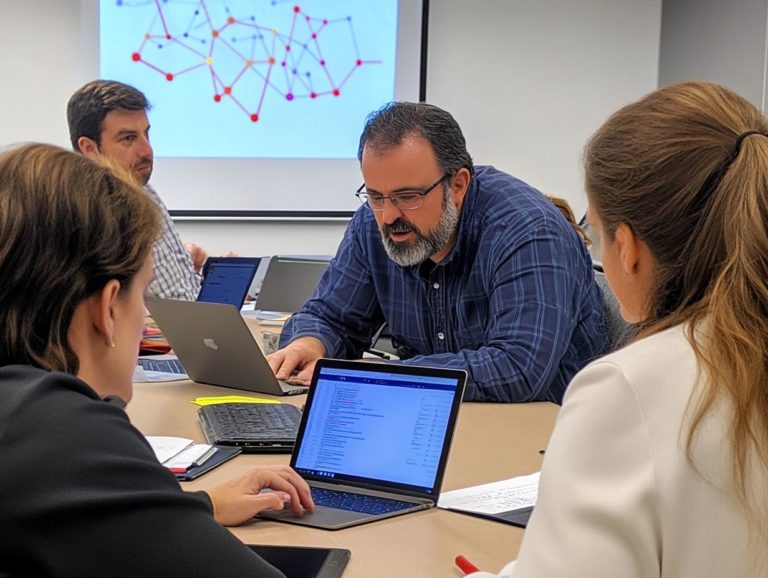Corporate Training vs. Professional Development: Key Differences
In today s rapidly evolving business landscape, investing in employee growth is not just beneficial; it s essential for any organization striving for success.
Corporate training and professional development are both important in enhancing skills and boosting performance, yet they serve distinct purposes. Recognizing these differences is crucial for businesses aiming to cultivate a highly competent workforce.
This article delves into the definitions, key distinctions, and benefits of both approaches, providing you with insights on selecting the right strategy tailored to your organization s needs.
Contents
- Key Takeaways:
- Defining Corporate Training and Professional Development
- Key Differences Between Corporate Training and Professional Development
- Why Corporate Training is a Game Changer
- Choosing the Right Approach for Your Organization
- Frequently Asked Questions
- What is the difference between corporate training and professional development?
- Is corporate training only for employees?
- What are some examples of corporate training?
- Can professional development be company-sponsored?
- How do the outcomes of corporate training and professional development differ?
- Are there any similarities between corporate training and professional development?
Key Takeaways:

- Corporate training focuses on specific job-related skills and is aimed at immediate workplace needs, while professional development has a broader scope and focuses on long-term career growth.
- Corporate training is typically delivered through formal, structured programs, while professional development can include a variety of methods such as conferences, workshops, and online courses.
- Corporate training is targeted towards employees, while professional development can also benefit managers, executives, and other professionals within an organization.
Defining Corporate Training and Professional Development
Corporate training and professional development are important for fostering employee growth within your organization, particularly in the ever-evolving business landscape. These interconnected concepts aim to equip you with essential job skills, promote continuous learning, and address any skill gaps that may impact your organization s performance.
By investing in effective training programs and mentorship initiatives, which involve pairing experienced professionals with less experienced employees for guidance, you can enhance employee satisfaction and engagement. This ensures that your team remains adaptable and ready to meet the changing demands of the business world.
Understanding the Purpose and Goals
The primary purpose of corporate training and professional development is to facilitate growth by addressing specific skill gaps and enhancing job performance through structured learning opportunities.
These initiatives refine leadership abilities, providing valuable frameworks that enable you to lead teams effectively. They also include technical training aimed at equipping you with the latest industry competencies, ensuring your technical skills align with current business needs.
Focusing on workforce development fosters an environment of continuous learning, which is essential for enhancing engagement and satisfaction. Effective training programs elevate employees’ capabilities and drive improved business outcomes, leading to increased productivity and overall success for the company.
Key Differences Between Corporate Training and Professional Development
Understanding the differences between corporate training and professional development helps organizations enhance workforce capabilities and foster meaningful performance improvement.
Recognizing these differences allows you to tailor your approach, ensuring that both individual growth and organizational goals align seamlessly.
Focus and Scope
The focus of corporate training often centers on immediate skill acquisition and job-specific competencies. In contrast, professional development casts a wider net, encompassing long-term career advancement and personal growth.
Effective learning strategies enhance immediate performance and bolster adaptability in an ever-evolving work environment. When you re encouraged to embrace lifelong learning, you re likely to feel more engaged and valued, which translates to higher job satisfaction. This sense of fulfillment is a key driver of improved retention rates; you re less inclined to explore opportunities elsewhere when you recognize a clear pathway for growth within your organization.
By aligning these development initiatives with organizational goals, you contribute to cultivating a culture of continuous improvement, which enhances overall performance and fosters a more resilient workforce.
Start investing in your employees today and watch your organization thrive!
Delivery Methods

The delivery methods used in corporate training and professional development can vary widely, from online learning platforms and engaging workshops to hands-on on-the-job training. Each method comes with its own set of advantages, designed to cater to different learning styles and organizational needs.
For example, online learning platforms provide flexibility and accessibility to learn at your own pace, which is particularly beneficial for visual and auditory learners. On the flip side, mentorship programs offer personalized guidance and promote employee engagement through direct interaction. This makes them a perfect fit for kinesthetic learners who thrive in collaborative settings.
Coaching sessions can hone in on specific skill development, allowing you to receive targeted feedback and make meaningful improvements.
Recognize the different learning preferences in your team to customize your training strategies. This maximizes effectiveness and ensures comprehensive employee development.
Target Audience
Identifying your target audience for corporate training and professional development initiatives is essential. It ensures that you’re addressing the right skills to bridge existing gaps within your organization.
This process involves understanding various employee demographics, such as age, education level, and work experience. These elements often influence preferred learning styles and the relevance of content for each group. Tailored training programs must consider these diverse needs to promote engagement and effectiveness.
Human Resources (HR) experts play a pivotal role in crafting targeted learning strategies. They utilize data analytics to evaluate current competencies and pinpoint gaps.
By fostering a comprehensive learning culture that values diversity, you can significantly enhance workforce development, ultimately cultivating a more agile and competitive organization.
Why Corporate Training is a Game Changer
The advantages of corporate training and professional development reach far beyond individual employees. They significantly contribute to the overall growth, success, and performance enhancement of the entire organization.
Investing in these initiatives not only elevates personal skills but also fosters a culture of continuous improvement that drives collective success.
Improving Employee Skills and Performance
Corporate training boosts skills and job performance. This can lead to happier and more engaged employees.
In today’s competitive landscape, organizations like yours implement targeted training programs that focus on technical skills, coaching techniques, and leadership development. By investing in these skill-building initiatives, you elevate your workforce’s capabilities while cultivating a culture of continuous learning.
When employees engage in mentorship and coaching, they frequently report heightened confidence and improved decision-making abilities. Leadership training programs prepare aspiring leaders to navigate challenges smoothly. This holistic approach elevates individual performance, fosters team cohesion, and contributes to overall organizational success.
Boosting Company Growth and Success
Investing in corporate training can supercharge your company s growth! It cultivates a skilled and adaptable workforce that meets market challenges head-on.
This proactive strategy enhances overall organizational performance and nurtures a culture of employee engagement, where team members feel valued and inspired to excel. As your employees acquire new skills and knowledge, their likelihood of staying with the company increases, leading to improved retention rates.
Planning for future leaders is essential. It helps your business handle changes smoothly. Ultimately, a well-trained workforce provides you with a formidable competitive advantage, enabling your company to navigate industry changes and seize new opportunities with unwavering confidence.
Don t wait to invest in your team’s growth. Start now to build a stronger, more competitive organization!
Choosing the Right Approach for Your Organization

Selecting the ideal approach for corporate training and professional development demands a thoughtful evaluation of your organization s unique needs, goals, and the current skill gaps present within your workforce. This tailored consideration ensures that your training initiatives resonate deeply and drive meaningful growth.
Considerations for Implementing Corporate Training or Professional Development
When you re rolling out corporate training or professional development initiatives, it s essential to think about employee engagement levels and do a detailed analysis of training needs. Evaluate the overall impact on performance improvement.
Aligning your training objectives with organizational goals is crucial for maximizing these programs’ effectiveness. HR experts stress that a comprehensive training needs assessment is vital not just for identifying skill gaps, but also for fostering adaptability among your employees. This approach ensures that the training is relevant and constructive.
By integrating measurable outcomes tied back to business objectives, you can cultivate a workforce that is both highly skilled and deeply motivated, ultimately driving sustained growth for your organization.
Combining Both for Optimal Results
Combining corporate training with professional development can yield optimal results, enabling your organization to craft comprehensive learning strategies that address both immediate skill gaps and long-term career advancement opportunities.
This integrated approach refines individual capabilities and cultivates a culture of continuous improvement and innovation within your workforce. Implementing engaging coaching sessions and workshops significantly elevates employee satisfaction and morale, leading to higher retention rates.
When your team members feel valued and enabled through targeted learning experiences, their commitment to your organizational goals deepens. This fosters enhanced collaboration and productivity. Ultimately, these holistic development strategies align personal growth with overarching business objectives.
Frequently Asked Questions
What is the difference between corporate training and professional development?
While both corporate training and professional development involve learning and improving skills, corporate training typically focuses on specific job-related skills necessary for an employee’s current role. In contrast, professional development emphasizes personal and career growth.
Is corporate training only for employees?

No, corporate training can extend to other individuals such as contractors, vendors, and partners who work closely with the company.
What are some examples of corporate training?
- Onboarding programs
- Technical training
- Compliance training
- Leadership development programs
Can professional development be company-sponsored?
Yes, some companies offer professional development opportunities for their employees, such as workshops, conferences, and certifications, to enhance their skills and knowledge.
How do the outcomes of corporate training and professional development differ?
The outcomes of corporate training are typically measured in terms of job performance and specific skills acquired. In contrast, the outcomes of professional development may include increased job satisfaction, career advancement, and personal growth.
Are there any similarities between corporate training and professional development?
Yes, both corporate training and professional development aim to improve an individual’s skills and knowledge. Both can contribute to the overall success of a company.
Act now to explore training options that align with your organizational goals and see immediate benefits!





